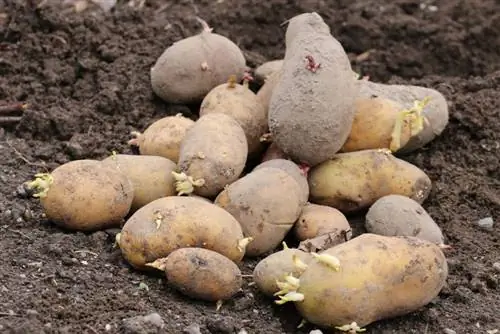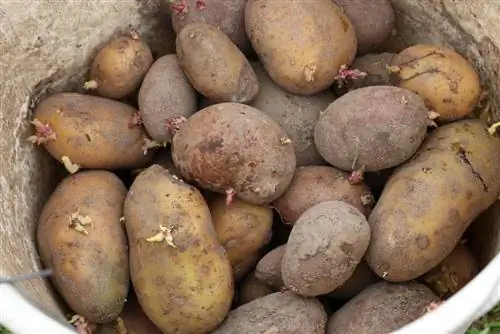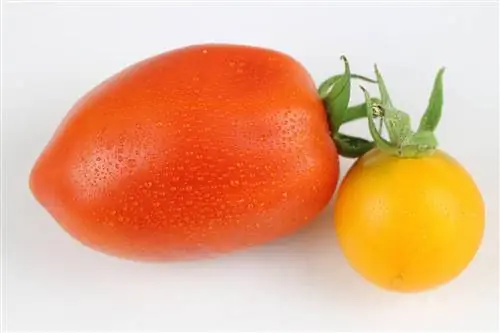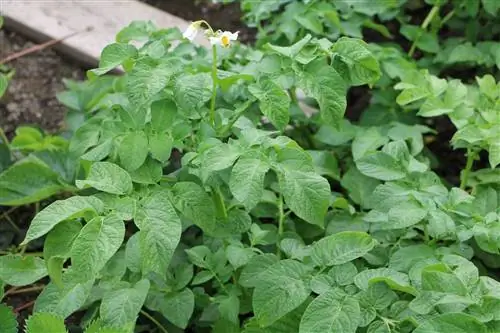- Author admin [email protected].
- Public 2023-12-17 03:39.
- Last modified 2025-01-24 12:45.
Low-fat he althy snack or high-carbohydrate fattening food? The potato polarizes. The image of our favorite supplement has been blameless for decades. No wonder: the starch-rich tuber only provides a little fat, but a lot of he althy ingredients. However, with the low-carb trend, the good reputation of the potato has begun to suffer considerable damage in recent years. Consumers are therefore increasingly unsure: Is the potato he althy and recommended - or just a classic fattening product?
Nutritional values at a glance
The potato is basically only edible when cooked - regardless of whether it is boiled, fried or baked. Prepared without additional ingredients, 100g of the starchy vegetable provides the following nutritional values:
- 70 calories
- 16g carbohydrates
- 2g protein
- 0, 1g fat
- 78g water
- 2, 1g fiber
The potato occupies an intermediate position between a vegetable and a starch side dish; On the one hand, it is often combined with different types of vegetables, and on the other hand, it replaces other starchy foods such as rice or pasta. While the tubers as a classic vegetable can certainly be considered high in calories - other varieties only provide half as many calories on average - as a starch side dish they provide less energy than, for example, rice or pasta.
The potato is not one of the protein-rich vegetables - but the proteins it contains are particularly valuable; This means they can be easily converted into the body's own proteins. At the same time, with a total of 0.1g fat, it is an extremely low-fat food. Most calories come from carbohydrates, which are made up of different components:
- Strength: 15g
- Sucrose (table sugar): 0.3g
- Glucose (dextrose): 0.24g
- Fructose (fruit sugar): 0, 17g
The low sugar content and high starch make it clear why potatoes are considered he althy. However, the starch molecules are quickly broken down into sugar molecules after consumption, so that the blood sugar level still rises quickly.
He althy tuber: micronutrients in potatoes
In addition, potatoes contain valuable micronutrients, i.e. vitamins, minerals and trace elements. B vitamins in particular are represented, but also iron. It contains a particularly high amount of the mineral potassium - here the potato provides 420mg per 100g.
Until a few years ago, potatoes were also an important source of vitamin C - especially in winter, when you could rely on stored vegetables. The valuable vitamin strengthens the entire immune system and protects against colds and inflammation, for example.
Potatoes contain so-called secondary plant ingredients, especially:
- Flavonoids
- Anthocyanins
- Carotionoids

These substances can primarily prevent cardiovascular diseases and fight bacteria, viruses and fungi. They also help lower cholesterol levels and have an anti-inflammatory effect. Various immune reactions in the body are also positively influenced by the secondary plant substances in potatoes.
Tip:
The content of these valuable ingredients varies depending on the method of preparation. Cooking vigorously without the peel drastically reduces the proportion of these substances.
Lose weight with potatoes
If you want to lose weight on a low-carbohydrate diet, you should generally limit your consumption of potatoes; The tuber is one of the most starchy vegetables. However, if you want to choose a suitable starch side dish, you should choose potatoes, which provide much fewer carbohydrates than pasta and rice - but offer many more he althy ingredients.
If you want to lose weight with the help of a low-fat diet, you should enjoy potatoes often - preferably boiled potatoes. The he althy tubers have a lasting satiating effect in combination with:
- Cauliflower or broccoli
- Types of cabbage, for example white cabbage or savoy cabbage
- Turnips
Keep an eye on blood sugar
As part of a he althy diet, attention to blood sugar often plays a role; In this way, people who want to lose weight avoid the sudden and rapid increase in glucose in the blood, because hunger is the result. Diabetics, on the other hand, are forced by their disease to avoid spikes in blood sugar. In both cases, the potato has come into disrepute in recent years because it causes glucose levels to rise sharply. Although the he althy tuber only contains a small proportion of free sugar - after consumption, the starch in the potato is quickly broken down into glucose molecules, which then enter the blood.
But completely eliminating vegetables from your diet for this reason is too short-sighted: With a few tricks, blood sugar spikes after eating potatoes can be reduced. Depending on the variety and method of preparation, the tubers contain certain amounts of so-called resistant starch. This type of starch offers the following advantages:
- cannot be digested in the small intestine
- therefore serves as food for the intestinal flora in the large intestine
- breaks down more slowly
- does not increase blood sugar
Tip:
The higher the proportion of resistant starch in the potato, the less strain is placed on blood sugar levels.
In order to increase the proportion of resistant starch, waxy varieties such as Nicola or Sieglinde should be chosen. Floury potatoes like Agusta or Adretta, on the other hand, increase blood sugar and the feeling of hunger. But there is also the possibility of increasing the proportion of resistant starch in the type of preparation; Anyone who prepares potatoes as boiled potatoes, then lets them cool completely and then eats them, also absorbs more of the cheap starch. Another option is to prepare the he althy tuber as a fried potato; However, due to the high amount of fat, this option is not recommended for those who want to lose weight.
It's all about the preparation
The correct preparation of potatoes not only plays an important role in connection with the resistant starch content; The total calorie content also varies depending on which dish is made from the vegetable. The following variants are favorable:
- Boiled potatoes
- Baked potatoes
- Mashed potatoes
For example, boiled potatoes or baked potatoes only provide around 70 calories per 100g, while fried potatoes or French fries easily provide three times as much. The hot air fryer is a new method of low-calorie preparation of French fries. Attention: Mashed potatoes are only low in calories if they are not prepared with cream and butter.

If the total calorie content plays a minor role and the he alth aspect is the main focus, particularly gentle preparation methods should be chosen; then all the valuable vitamins and minerals remain in the potato. Vitamin C in particular is quickly lost if stored and prepared incorrectly - around 15% in the following types of preparation:
- Cooking
- Stewing
- Pressure cooking
In order to preserve all the ingredients, it has proven to be a good idea to gently cook the potato with the peel on.
He alth hazard alkaloids
Potatoes not only contain he althy components, but also the poisonous solanine - easily recognizable by its green color. The harmful ingredient is mainly formed under the following conditions:
- Pest infestation of the potato plant
- strong incidence of light during growth
- mechanical injuries
- Storage at high temperatures
Solanine is mainly found in the shell, but the uncooked tuber also contains this substance; For this reason, the potato can only be eaten when cooked.
Note: The first symptoms of solanine poisoning occur in an adult after eating around 3 kg of raw potatoes.
In order to keep the solanine content as low as possible, the following instructions should be taken into account:
- Storing potatoes in a cool and dark place
- generous removal of green areas
- Prefer large potatoes (less peel)
Conclusion
The potato cannot be generally described as a fattening food or a he althy snack; It all depends on what purpose the versatile tuber is to be used for. In any case, the potato offers classic enjoyment.






